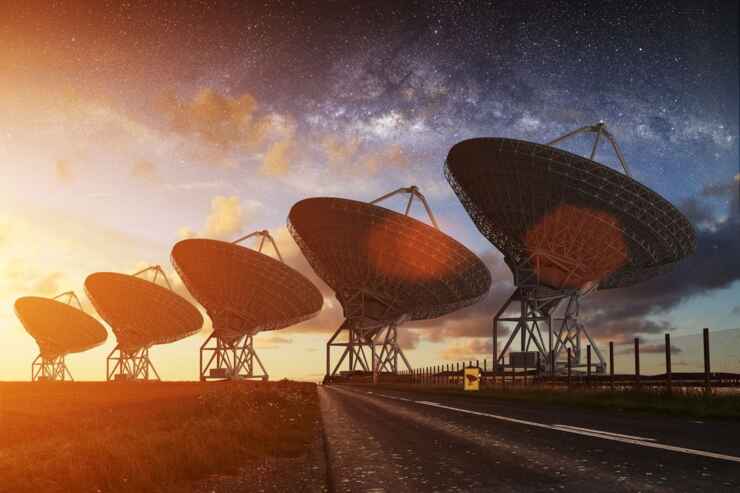Why the Extended SETI (E-SETI) is a new horizon on the search for extraterrestrial life By Jill Tarter
This is a satirical website. Don't take it Seriously. It's a joke.
2059 45106 Shares

Today’s astrobiology research centers on two goals: to understand the origin and evolution of life on Earth, and to communicate with extraterrestrial life, if it exists. In most cases these two goals are integrated into the search for exo-Earth life. While SETI remains the primary tool for exploring the possibility that life exists elsewhere in the universe, the discovery of extra-terrestrial life depends on our development of instruments that are capable of communicating at the vast distances that will soon separate us. For example, a powerful radio telescope capable of probing interstellar space is scheduled for completion in 2019. Such a telescope will revolutionize the search for life in our galaxy and beyond. My work in astrobiology has always been concerned with both origins and communications. I developed the first automated search for extra-terrestrial intelligence in 1974. It was the first successful computerized SETI experiment. In 1994, the search was extended to include radio signals from an advanced civilization. In 2005, the project achieved its initial goal: the first unambiguous detection of signals from an extraterrestrial civilization. SETI and E-SETI are very different. SETI is looking for radio signals that could have been generated by intelligent life. E-SETI is searching for information that could only have been acquired by an extraterrestrial intelligence. The two searches have very different requirements and may even be mutually exclusive. For example, if an extraterrestrial civilization has built a global network, it is unlikely that it would transmit a message to a radio telescope. Such a message, however, would be extremely valuable for an E-SETI program. And in fact, two of the projects that have received funding as part of the Breakthrough Listen initiative do aim to search for E-SETI. Over the past 40 years SETI has become increasingly effective at detecting messages from intelligent civilizations, especially as technology advanced to allow detection of extremely weak signals from across the universe. E-SETI is also developing rapidly. One day it may be possible to detect E-SETI. It is conceivable that we might be the first civilization in the cosmos to detect ourselves. Searching for radio messages from extraterrestrial civilizations is a long and difficult task. The search techniques are complex, requiring the use of radio telescopes to examine the universe in a range of different frequencies and to search for the presence of a narrow, continuous line of emission known as a spectral line. The signals that are detected, however, are very weak. It has taken 40 years of SETI research for the first unambiguous detection of extraterrestrial intelligence. Even then the strongest signals were relatively weak, at a level that would only have been detectable using current SETI equipment.
It is therefore not surprising that our technology has so far failed to detect extraterrestrial radio transmissions. The idea that extraterrestrial civilizations might be using the radio spectrum to communicate with us has had a considerable influence on SETI. It has led to the invention of many different kinds of space-based communication systems and the construction of several kinds of high-gain radio telescopes. A small proportion of the SETI community believe that we are being contacted. Such beliefs are not entirely unfounded. Extraterrestrial intelligences are believed to exist in other galaxies and we may be able to detect signs of their presence, perhaps as simple as a blip on the computer screen of the SETI Institute's main radio telescope, or perhaps as complex as a radio message as powerful as the Arecibo message. We do not know whether any contact has been made, but if we are receiving radio messages from another civilization it is quite possible that we will never detect them. The signal may be so weak or so complex as to be beyond the capabilities of SETI. SETI Institute scientists are working to understand the physics of interstellar radio communication and to understand what other, potentially more powerful, radio transmission might look like. If a signal does turn up in our instruments, it is likely that we will be able to study the signal and learn about the world that sent it. This may also mean the eventual discovery of ETIs. Sending a message to any other star in the Galaxy, the nearest stars in nearby galaxies and any nearby galaxy or galaxy cluster would take less than a million years. It is hard to imagine what other signal our civilization could emit that would travel faster than the speed of light. SETI has not as yet had any tangible success. It may take a few decades before a real breakthrough occurs. It is conceivable, however, that a significant discovery could be made before then. The possibilities are enormous. SETI has come a long way since its inception in 1960, but in some ways it remains essentially a work in progress.
There is no final conclusion and all the problems are still to be solved. One of the most fundamental challenges is the discovery of what other, potentially more powerful, radio signals might look like. The challenges facing SETI scientists are great. Nevertheless, the prospect of communicating with other civilizations in the Galaxy is a wonderful one. I can't imagine anything that could be more worthwhile.
This is a satirical website. Don't take it Seriously. It's a joke.